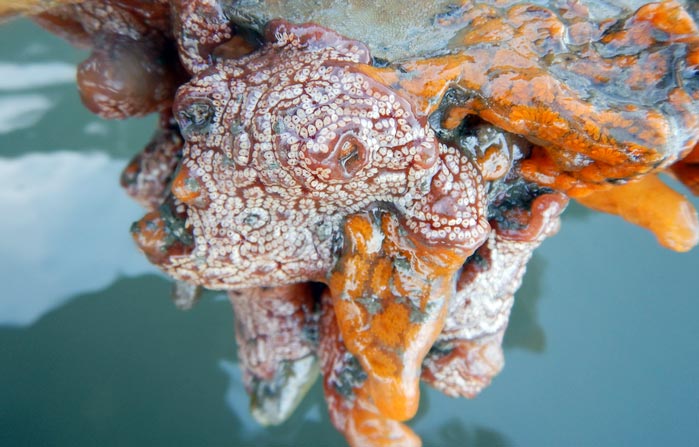Invasive species and climate change impact coastal estuaries

A mix of non-native and native colonial ascidians compete for space on a settlement plate as part of a scientific study.
Credit: Ben Rubinoff, UC Davis
Biological invasions interact with changing climate in unpredictable ways.
Native species in California’s estuaries are expected to experience greater declines as invasive species interact with climate change, according to a study from the University of California, Davis.
The study, published in the Ecological Society of America’s journal, Ecology, said these declines are expected not only because of climate-related stressors, but also because of the expanding influence of new invasive predators whose impacts are occurring much farther up the estuary.
“Our study found that climate change and biological invasions can interact in coastal estuaries in unpredictable ways,” said lead author Benjamin Rubinoff, a Ph.D. student in the UC Davis Department of Environmental Science and Policy when the research was conducted. “This increased risk of predation makes it difficult for native species that are already dealing with increasingly stressful environmental conditions.”
The researchers tested the influence of environmental stress and predation on sessile invertebrates in Tomales Bay, California during the summer of 2019. Sessile invertebrates are animals without backbones that attach to reefs or seagrasses and barely move, such as bryozoans and ascidians. Their predators include sea stars, crabs, and snails, among other species.
Estuaries a unique environment
In estuaries, changes in salinity and water temperature strongly influence the distribution of many invertebrate species, from mussels to crabs to sea squirts. These gradients can be especially steep in the estuaries of California, which are highly vulnerable to climate change and invasive species.
In most estuaries, stressful conditions for marine organisms such as low salinity and high temperature increase as you move inland from the ocean. With increased stress, native predators typically consume fewer prey.
But the study found that biological invasions are changing this equation, since many non-native predators tolerate stress better than native ones. So highly stressed native prey species are subjected to large numbers of stress-tolerant invaders that compete with them for resources, if not consume them.
Stressful situation
“The stress gradients typical of West Coast estuaries are being rapidly altered by climate change,” said co-leading author Edwin “Ted” Grosholz, a UC Davis professor with the Department of Environmental Science and Policy and the Bodega Marine Laboratory. “These changing gradients are scrambling the historical predator-prey landscape, creating novel matchups and putting native prey at much higher risk from invaders.”
Grosholz adds that such changes are hard to predict, and only experimental studies like this can disentangle the interacting effects of climate change and invasions on struggling native species.
For the study, the researchers deployed square plates made of PVC with different caging treatments at three locations across Tomales Bay from June to October 2019. Some plates were protected from predators while others allowed predator access. At the end of the period, the researchers brought the plates back into the lab and identified organisms using a microscope and determined percent cover.
The study was funded by grants from UC Davis and Point Reyes National Seashore Association.
Journal: Ecology
DOI: 10.1002/ecy.3695
Method of Research: Experimental study
Article Title: Biological invasions alter consumer–stress relationships along an estuarine gradient
Article Publication Date: 30-Mar-2022
All latest news from the category: Ecology, The Environment and Conservation
This complex theme deals primarily with interactions between organisms and the environmental factors that impact them, but to a greater extent between individual inanimate environmental factors.
innovations-report offers informative reports and articles on topics such as climate protection, landscape conservation, ecological systems, wildlife and nature parks and ecosystem efficiency and balance.
Newest articles

Innovative 3D printed scaffolds offer new hope for bone healing
Researchers at the Institute for Bioengineering of Catalonia have developed novel 3D printed PLA-CaP scaffolds that promote blood vessel formation, ensuring better healing and regeneration of bone tissue. Bone is…

The surprising role of gut infection in Alzheimer’s disease
ASU- and Banner Alzheimer’s Institute-led study implicates link between a common virus and the disease, which travels from the gut to the brain and may be a target for antiviral…

Molecular gardening: New enzymes discovered for protein modification pruning
How deubiquitinases USP53 and USP54 cleave long polyubiquitin chains and how the former is linked to liver disease in children. Deubiquitinases (DUBs) are enzymes used by cells to trim protein…



